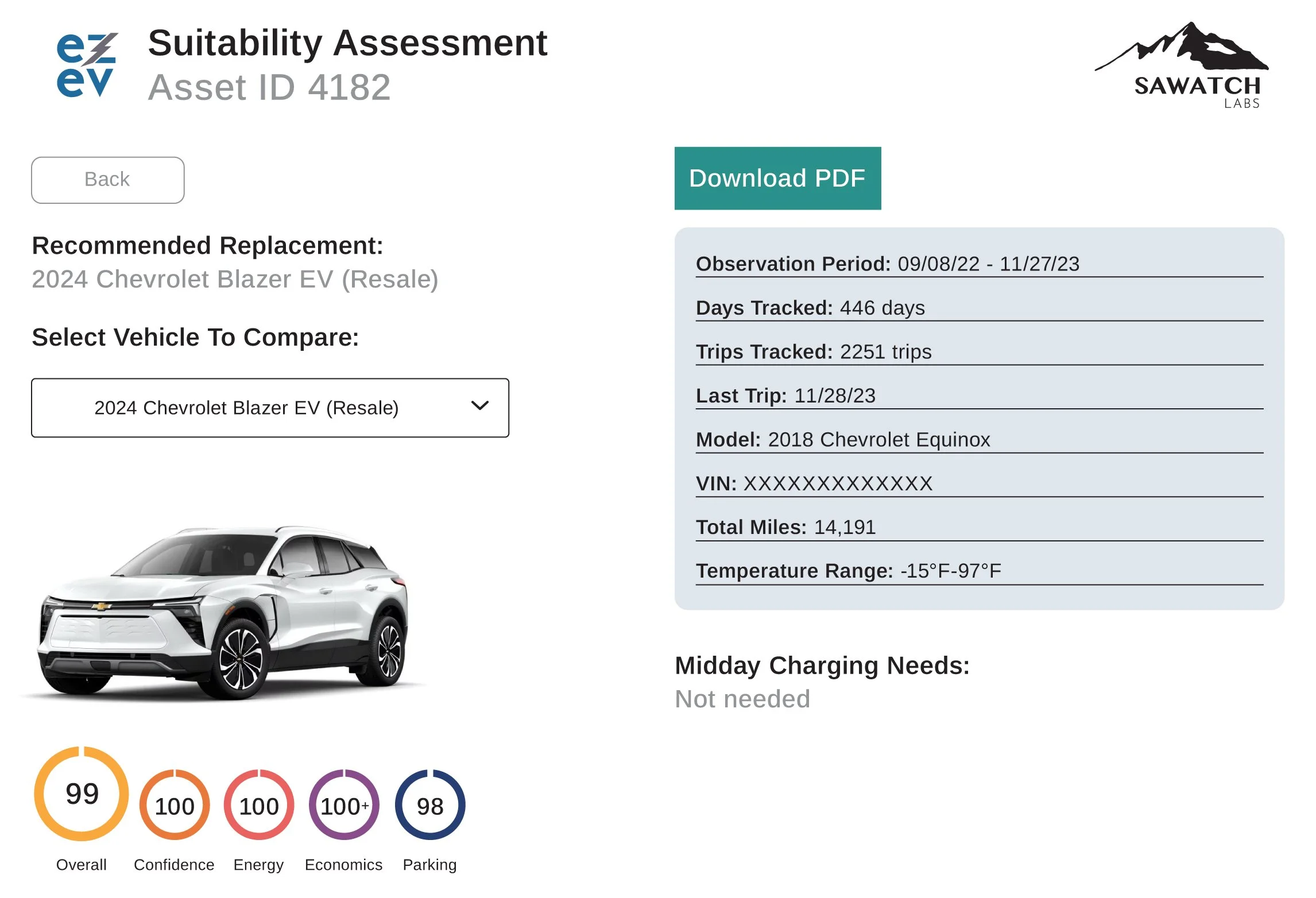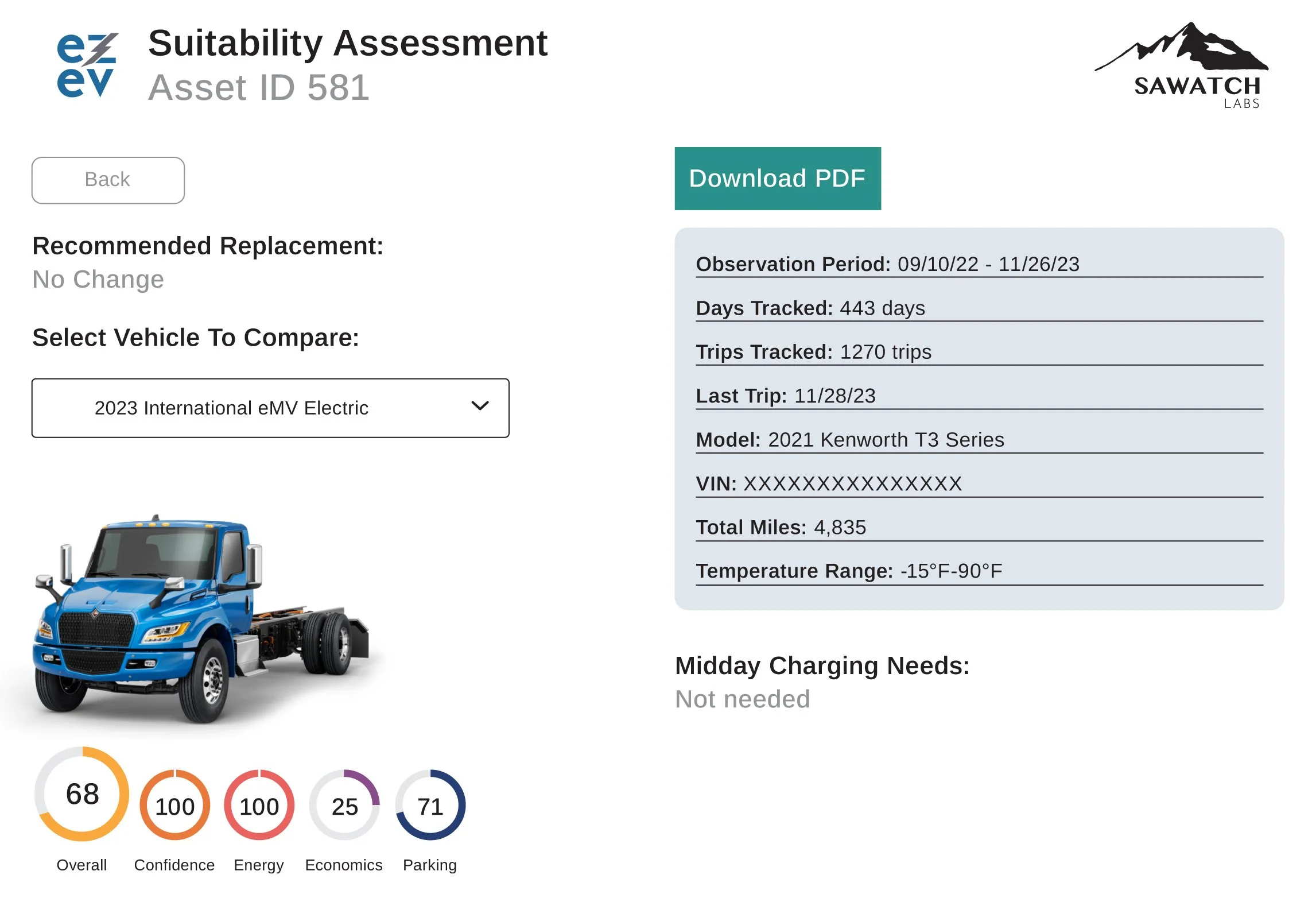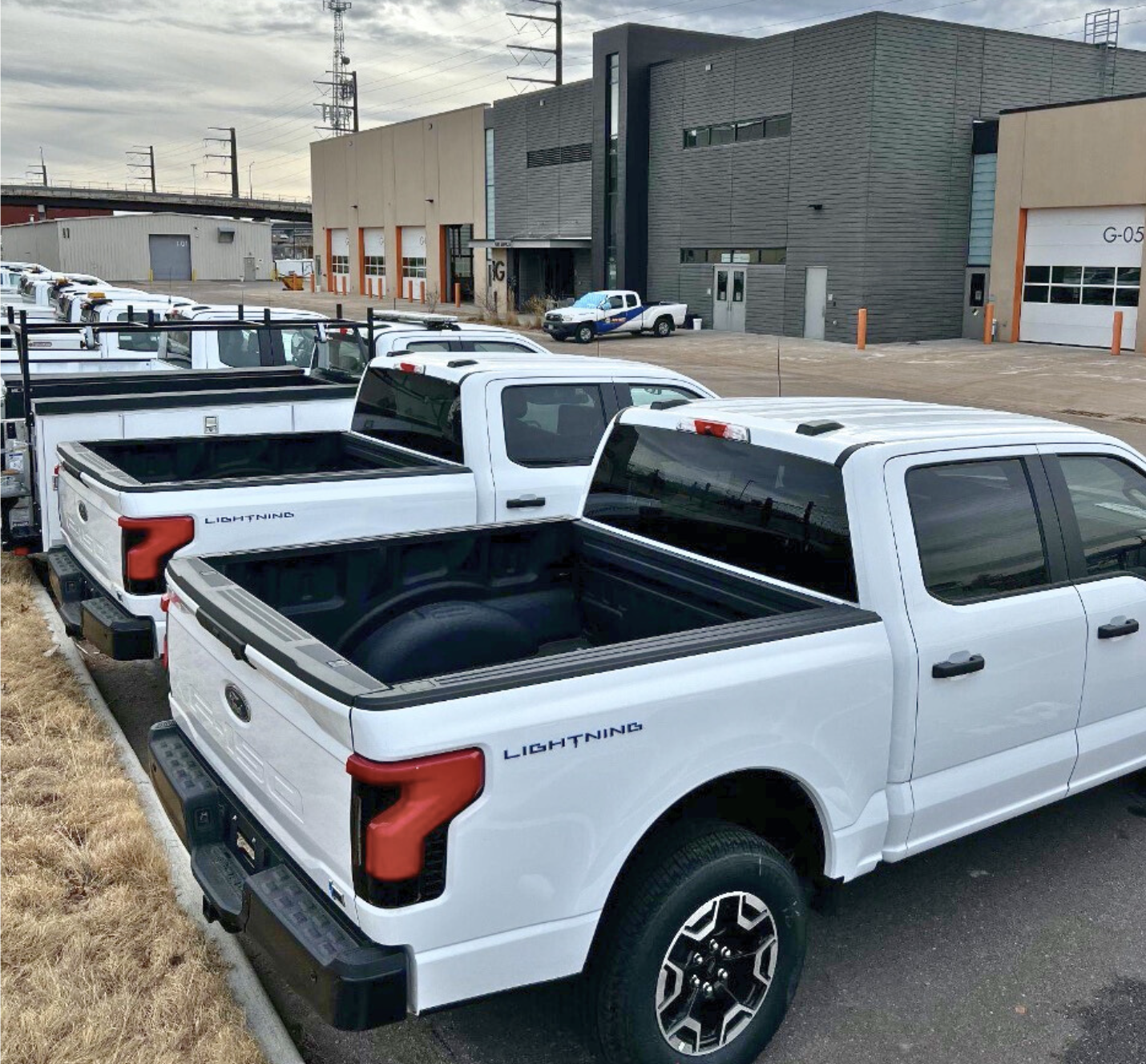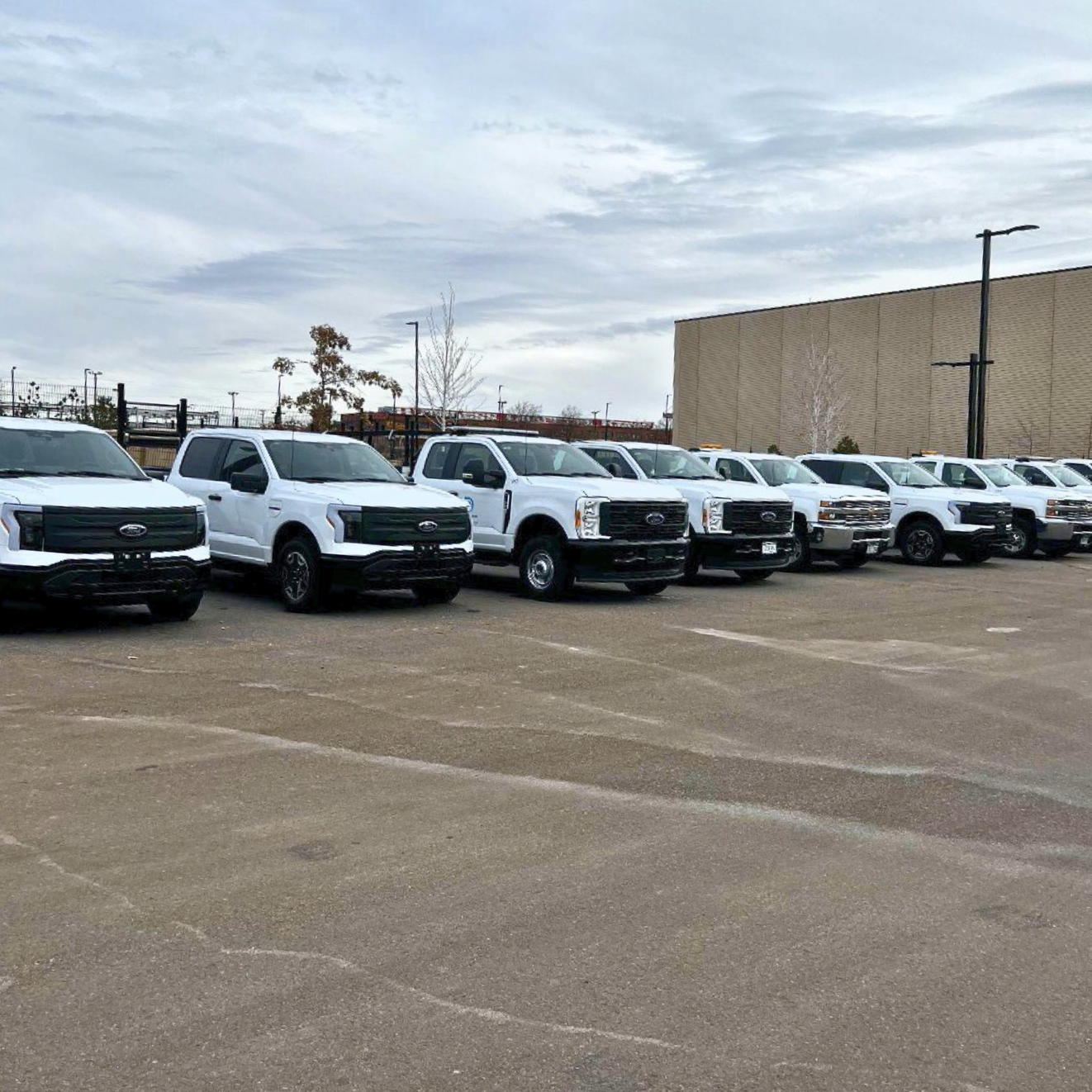Sawatch Labs Helps Denver Water Reduce Fleet Emissions
Denver Water has long been recognized as a leader in sustainability. With a dedication to environmental stewardship, the organization has a strong focus on energy and water conservation. Recently, Denver Water has established an initiative to reduce fleet emissions.
The Challenge: Determine Which of 490 On-road Vehicles are Candidates for Electrification
Transportation accounts for a large portion of Denver Water’s emissions. The fleet consists of approximately 750 assets operating in a large geographic area spanning 335 square miles. Recognizing this potentially significant opportunity to drastically slash both greenhouse gas (GHG) and particulate emissions through vehicle electrification, Denver Water decided to undertake a study of their 490 on-road vehicles. Xcel Energy funded the analysis through their Fleet Electrification Advisory Program (FEAP). The Xcel Energy FEAP program begins with an analysis conducted by Sawatch Labs to help organizations determine the best course of action for electrification.
Our Solution: Conduct a Comprehensive Analysis of Vehicle Operations
The Denver Water fleet vehicles have unique operations and are integral in ensuring residents have access to clean, reliable water. So, it is no surprise that the number one priority is understanding if and when an EV can meet the daily driving needs of a vehicle before considering replacing it. Sawatch Labs analyzed the minute-by-minute operations of each vehicle using the fleet’s existing telematics data, to identify where EVs meet Denver Water’s driving requirements.
Denver Water conducted the analysis using Sawatch Labs suite of EV software, including:
ezEV
ezIO
EMIT
ezEV assesses each vehicle’s operations, identifying when a vehicle is well suited for electrification by determining their daily energy use and total cost of ownership. Planning charging infrastructure deployment is simplified using ezIO which projects when, where and for how long vehicle charging will occur at each parking facility. The EMIT software tracks emissions and savings from deployment of alternative fuel vehicles. Using EMIT, Denver Water established a baseline for current emissions, identified specific vehicles or fleet segments that offer the greatest opportunity for reducing emissions, and tracked emissions reductions over time.
Sawatch Labs’ innovative analytics platform uses vehicle operational data collected through vehicle telematics. Because of the quality and quantity of data available through telematics data, the Sawatch Labs’ analyses provide a high degree of accuracy and confidence. The type of analysis conducted by Sawatch Labs allows organizations to set a baseline for current emissions, identify vehicle candidates whose daily use patterns are well suited to electrification, and fine-tune EV charging infrastructure siting and development.
Performing the Study and Analyzing the Findings
The vehicles in the Denver Water analysis included a mix of SUVs, sedans, ½-ton and ¾-ton pickups, and class 3-8 vehicles, many of which are up-fitted with specialized equipment required by the nature of the operations. To account for seasonal fluctuations in fleet operations and ambient temperatures, 14 months of vehicle data was used in the analysis.
Accurate vehicle pricing is a critical component of all Sawatch Labs analyses. Vehicle prices can be variable, and factors like MSRP, contract pricing, vehicle trim, and even lease parameters, among many others, must be considered. Like many fleet operators, Denver Water partially funds new vehicle procurements with auction proceeds from the sale of vehicles being retired from the fleet. The analysis reflected recent auction sale data, which further increased the accuracy of total cost of ownership projections. Vehicle pricing scenarios, vehicle service life, observed maintenance costs per mile, and fuel prices, including specific seasonal and time of use kWh rates, were adjusted throughout the study to reflect current conditions.
The Result: Significant Projected Emissions Reduction & Reduced Fleet Spending
Upon reaching the end of the data collection phase of the study, ezEV identified 63 vehicles as good candidates for electrification. Each of the 490 vehicles analyzed was scored against available in-class electric alternatives. Scores given reflect the projected performance of an EV if it was operating in place of the existing fleet vehicle, including daily energy use, parking and charging accessibility, and total cost of ownership. Scores are aggregated, weighted, and ultimately used to assign each vehicle an overall score, allowing fleet operators to make significantly more informed procurement decisions.
The majority of the 63 vehicles identified as good candidates for electrification were light-duty vehicles. They included a mix of ½-ton pickup trucks and SUVs. A BEV was identified as the best fit for 61 of those vehicles, and a PHEV was the best fit for the remaining two vehicles. If Denver Water transitions the 63 vehicles to their recommended EV replacement, they are projected to reduce fleet spending by $360,000 and reduce GHG emissions by 1,000 tons.
Interpreting the Results
The analysis did not recommend replacing any medium- or heavy-duty vehicles with an electric option. Interestingly, Sawatch Labs identified many Class 5 and larger vehicles in the study for which an EV would meet daily operational needs. However, the higher purchase price for medium- and heavy-duty electric vehicles is such that, for Denver Water’s fleet, the total cost of ownership is higher compared to ICE models.
This finding is important because even with the added energy requirements of their upfits, there are EVs available today that are suitable for Denver Water’s daily operations. These findings will be used to inform future MD/HD vehicle procurements and help support potential grant applications. By accounting for the energy needed to fuel an entirely electric vehicle fleet, Denver Water can also use the analysis results to plan for immediate and future infrastructure build out.
The analysis identified each facility and location where these vehicles are projected to charge. Additionally, for each site, the ezIO software provides the number of ports needed, projects the peak energy demand, and 15-minute demand curve at various levels of fleet electrification. In the case of Denver Water, the organization is able to use these findings to target specific facilities for initial charging infrastructure deployment. These findings are also informing the development of long-term infrastructure plans, leading to significant time and budgetary savings.
Implementing the Strategy to Reduce Fleet Emissions
With the help of Sawatch Labs, Denver Water is developing its long-term strategy to reduce overall fleet emissions. Actual operational data will support fine-tuning decisions for vehicle procurement and charging station infrastructure installations. The insights gained from this analysis will save time and money while minimizing impacts on daily operations.
““Wanted to express our gratitude... for all of your support! We have certainly gotten a lot of this service, and we have really enjoyed working with you all to start developing our strategy for the electrification of our fleet!””
The Denver Water fleet has already used the findings from the study to begin purchasing electric vehicles and installing additional charging stations. Since completing the analysis, Denver Water has taken delivery of seven Ford F-150 Lightning EVs. Additionally, the fleet has placed orders for four Chevy Blazer EVs, citing the results of the analysis as the primary factor in the decision to purchase. The ezIO analysis informed the installation of four dual port Level 2 chargers and one single port Level 2 charger at their campus location to support charging for the new EVs.
As the fleet continues to expand the number of electric vehicles in its fleet, the ezEV, ezIO, and EMIT results will inform decisions impacting the entirety of the organization from fleet and facilities to sustainability, finance departments, and perhaps most directly, drivers.






